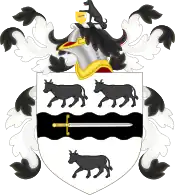
Michael Metcalf (1586 – 27 December 1664) was an early English colonist in Massachusetts, who had been persecuted for his Puritan beliefs in his native England.[1][2]
Metcalf was from Norwich, England and worked as a master weaver.[3][2] His father was a Puritan minister.[2] He was persecuted by Bishop Wren and the Church of England for his Puritan beliefs and, upon fleeing to Massachusetts, wrote a long letter addressed to "all true professors of Christ's gospel" in Norwich.[3][2] He spoke of the "great trouble" he had with the "Arch-Deacon's and Bishop's court at the hands of my enemies concerning the matter of bowing as well as for other matters of like consequence."[3]
Before the ecclesiastical court, Metcalf defended himself by quoting not only the Bible but also the church's own theologians.[3] He related in his letter that their responses included "Blockhead, old heretic, the devil made you, I will send you to the devil."[3] When his life was put in danger, his wife sometimes hid him in the thatched roof of their house.[3][2] He left London on September 17, 1636, and arrived in New England on Christmas.[2] He left his wife and children behind in England.[2]
Metcalf was one of the first residents of Dedham, Massachusetts and a signer of the Covenant.[3][4] In 1641, he served as Selectman.[5] At the age of 70 he began teaching reading in the Dedham Public Schools, the first system of its kind in the country.[4] In 1652, Metcalf purchased a joined armchair that is today the oldest dated piece of American furniture.[6][7]
His descendant, Father Theodore Metcalf of the Cathedral of the Holy Cross in Boston, served as Master of Ceremonies at the laying of the cornerstone ceremony at St. Mary's Church in Dedham in 1880, 244 years after Metcalf arrived in Dedham.[8]
References
- ↑ Goodwin, Nathaniel (1856). Genealogical Notes Or Contributions to the Family History of Some of the First Settlers of Connecticut and Massachusetts. Hartford: F. A. Brown. p. 157. ISBN 9780806301594.
- 1 2 3 4 5 6 7 Hanson 1976, p. 33-34.
- 1 2 3 4 5 6 7 Lockridge 1985, p. 57.
- 1 2 Jennifer Monaghan. "Literacy instruction and the town school in seventeenth-century New England". University of Illinois at Urbana-Champaign. Archived from the original on September 11, 2006. Retrieved December 10, 2006.
- ↑ Worthington 1827, p. 79-81.
- ↑ St. George, Robert Blair (1979). "Style and Structure in the Joinery of Dedham and Medfield, Massachusetts, 1635–1685". Winterthur Portfolio. 13: 1–46. doi:10.1086/495859. ISSN 1545-6927. JSTOR 1180600.
- ↑ "Collections". Dedham Historical Society. Archived from the original on December 9, 2006. Retrieved 2006-12-10.
- ↑ "Suburban Matters". Boston Post. October 19, 1880. p. 4. Retrieved March 9, 2015 – via Newspapers.com.

Works cited
- Lockridge, Kenneth (1985). A New England Town. New York: W.W. Norton & Company. ISBN 978-0-393-95459-3.
- Worthington, Erastus (1827). The history of Dedham: from the beginning of its settlement, in September 1635, to May 1827. Dutton and Wentworth. Retrieved November 8, 2019.
- Hanson, Robert Brand (1976). Dedham, Massachusetts, 1635-1890. Dedham Historical Society. p. 35.